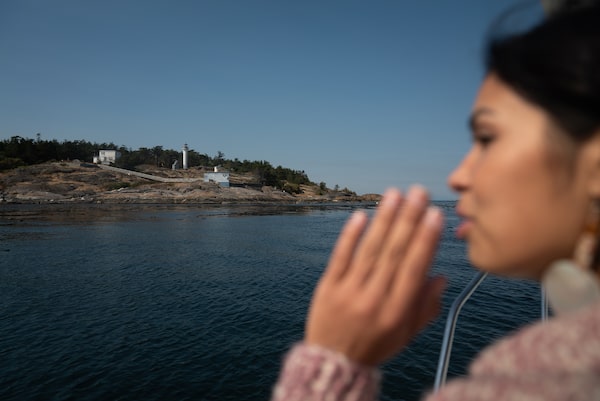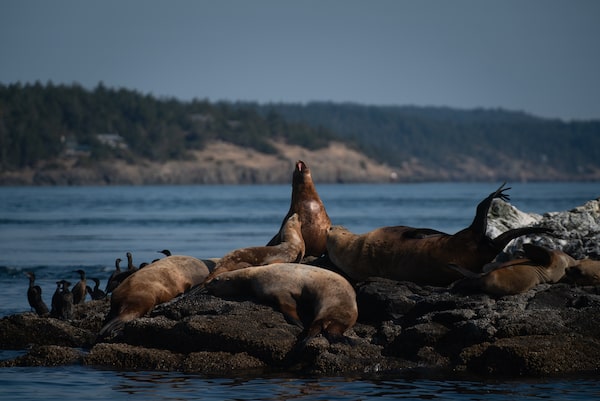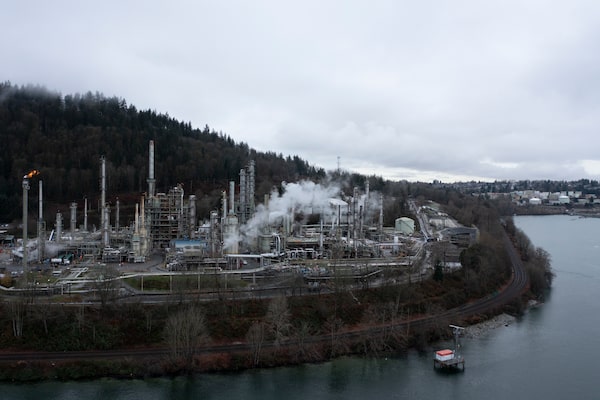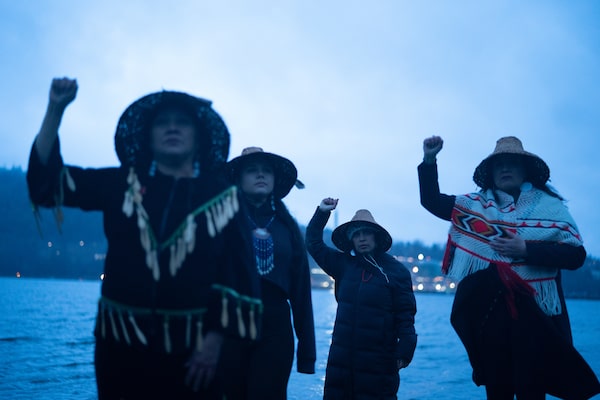Kayah George, 24, a Coast Salish matriarch-in-training and climate leader, is on a boat visiting her orca relatives in Oak Bay, Victoria, on a cold September day. Kayah (her first name means “wolf” in Tsleil-Waututh) is the great-granddaughter of the celebrated Chief Dan George, the granddaughter and niece of Tsleil-Waututh matriarchs Amy George (Ta7ah) and Charlene Aleck, respectively, and daughter of Tulalip matriarch Deborah Parker.
“Orcas are matriarchal,” Kayah states proudly. “Much like our people, they have their own individual family systems, their own songs, dialects, culture and ways of being, living and interacting with the world that are passed down through generations. They always stay with the grandmother, who leads the pod. And that’s much like our people. My Ta7ah is the one who brings the family together. She’s the last of her siblings and one of the oldest in the nation. She holds the songs and teachings, and that’s the sacred duty of the Elders.”
:format(jpeg)/cloudfront-us-east-1.images.arcpublishing.com/tgam/FXAJLUJBFNG6LHLSBXJKKREW2U.jpg)
:format(jpeg)/cloudfront-us-east-1.images.arcpublishing.com/tgam/V7GELQ77TVDY3DIGSQWALRFTXE.jpg)
Kayah is travelling with boat captain Brian Glennon, a naturalist who advocates for the marine life around Victoria. He tells her that the orcas have been avoiding this region since September, 2022, after diesel fuel from a sunken fishing boat leached into the ocean. However, they’ve just spotted two brother orcas – “Onca” and “Lynx.” For Kayah, this is a special gift for more reasons than one.
“When I saw it was two brothers, I thought, wow … it’s like that story from all those years ago when our people were starving because the salmon were being completely eaten by the seals. Two brothers took it upon themselves to do something about it … they went into the water where they suddenly grew larger and transformed into beings with black-and-white skin and a blowhole … and in their new form they hunted the seals. Soon the salmon started to return and the people flourished again. That’s why we are always indebted to the orcas and see them as our relatives,” she explains.
Orcas are matriarchal. Much like our people, they have their own individual family systems, their own songs, dialects, culture and ways of being, living and interacting with the world that are passed down through generations.
— Kayah George
Orcas of the North Pacific exist in distinct resident and transient groups – residents stay near shore, while transients travel as far as Southern Californian waters. The transient orcas – of which there are 450 – have fared better than the resident orcas in terms of numbers, because they eat seals, which are an abundant food source.
The southern and northern residents (J, K and L pods), on the other hand, feed on salmon, which are under threat from human factors such as salmon farming and effluent dumping. “In 2000, if you looked at the southern resident population it was over 100,” says Glennon. Now, according to the Department of Fisheries and Oceans, there are 73.
Climate Innovators and Adaptors
This is one in a series of stories on climate change related to topics of biodiversity, urban adaptation, the green economy and exploration, with the support of Rolex. Read more about the Climate Innovators and Adaptors program.
Orcas have a massive capacity for memory, navigation, communication and data processing, evidenced by the size of their brain (the second-largest of all ocean mammals), the thickness of their cerebral cortex, and the gyrification of their brain, the most gyrified in the world. (The more gyrified the brain, the greater surface area, which correlates with greater cognitive functionality.) Orcas also have the most elaborated insular cortex in the world, which is involved in emotional reasoning, compassion, empathy, perception, motor control, self-awareness and interpersonal experience.
In 2021, Dalhousie University’s Dr. Hal Whitehead co-authored a paper suggesting that, aside from humans, no species are as “cultural” as orcas. “Culture is about learning from others. A cultural species starts behaving differently than a species where everything is determined genetically,” said Whitehead.
Chief Dan George, Kayah's great-grandfather, in 1971. George was a chief of the Tsleil-Waututh Nation.John McNeill/The Globe and Mail
Kayah says that her people have known all of this for far longer than modern scientists, and that in her communities, their relationship with orcas goes back generations. “We have stories of our people going whaling hundreds or thousands of years ago and always leaving the tongue for the orcas. We knew it was their favourite part. That’s how we grew our relationship with them. It’s very rare for them to harm humans or have any interest in harming them and I believe it’s because of the relationship we had with them … the respect we had.
“My Ta7ah also told me the story of how my great-great-grandfather’s body was buried next to Science World in Vancouver. In the late 1800s to early 1900s, the colonizers wanted to construct buildings there and they made us move his remains to Tsleil-Waututh reserve land that we were forced onto. Our people were carrying his remains in a canoe when a pod of orcas came and escorted them. The orcas weren’t afraid and neither were we.”
WATCH:
Kayah George, a Coast Salish matriarch-in-training, sings an orca song while out on a boat visiting her orca relatives in Oak Bay, Victoria. The song was created by her Ta7ah (grandmother) Amy George, a Tsleil-Waututh matriarch.
The Globe and Mail
Unfortunately, this relationship, and therefore thousands of years of cultural reciprocity and knowledge, was disrupted by settler colonialism in a region that is to this day still considered “unceded” or unrelinquished land.
“There’s much to be learned about the parallels between Indigenous Coast Salish peoples and orca whales, particularly around the consequences of trauma from colonization,” says Kayah. “My great-grandfather, for example, was born in 1899 and grew up in a longhouse. His childhood was disrupted and he was taken to residential school. By the time he came back, his family was suddenly living in a house. They also took the big orcas from their pods and put them in aquariums. They even encouraged people at one time to shoot them with machine guns. … With young orcas being taken away, you can see the impact on the pods. With young Indigenous kids taken away, you can see the impact on families and communities … Both us have had our own taken, killed, and poisoned, and this has had really detrimental effects on culture and the continuation of our way of life. I think of the Elder matriarchs from both our communities and all of the things they must have seen. It saddens me to know how much of their culture is being lost and how many stories of trauma they are passing down.”
With young orcas being taken away, you can see the impact on the pods. With young Indigenous kids taken away, you can see the impact on families and communities.
— Kayah George
Kayah and her aunt, Charlene Aleck, are part of the Sacred Trust Initiative, a Tsleil-Wautituh effort to enact sovereignty of their land and traditions to protect the land and water from pipeline expansion and other entities. Aleck recently went to Miami Seaquarium to advocate for the return of Tokitae, also known as “Lolita,” a southern resident orca who was stolen from L Pod in 1970 when she was only four years old.
“A while back, some people snuck in to see Lolita and they had a recording of her home pod,” Glennon, the boat captain, remembers. “She just freaked out when they started playing the recording. She remembered. She’s been banging her head against the wall at that aquarium for years and now that she’s reaching the end of her life, they are finally talking about releasing her … normally captive orcas only last about 20 years. It’s sad.” Tokitae is now bound to be returned to her home waters, but it is unknown how she will fare being transported such a distance at the age of 59.


As we stand on the boat, we can see seals and Steller sea lions, cormorants and other birds gathering near the rocky shore in the distance. The two orca brothers have stopped next to our boat, so we lower the hydrophone into the water and listen for the telltale clicks of echolocation. “They can hear our heartbeats, our voices, the vibrations. They can tell how many people are on board, what species we are, what our physical condition is. Coast Salish songs are always low and slow … I would always fall asleep to our songs at gatherings, comforted by the vibrations. My Ta7ah created an orca song, so I sang it for the orcas, just to honour them. I wondered if they remember it …”
It is hard to forget the image of Tahlequah, an endangered southern resident orca, who carried her stillborn calf for seventeen days and one-thousand miles in 2018. Its death was likely a result of contaminants that are lipophilic, meaning they bind to fat. Orca mothers transfer fat-laden milk to their babies, and the first pregnancy is where they off-load the most chemicals, which can lead to a stillbirth or miscarriage. A recent study showed that chemicals found in sewage sludge and waste water can be found in the orca population. “It’s upsetting the balance system. It feels like everybody treats the ocean like a giant garbage can because they can’t see it,” says Glennon. “Her calf didn’t have to die,” Kayah states. “That was her taking a stand and doing an action, just like my people keep doing today.”

The heavily industrialized mainland stands in stark contrast to the pristine island lands of the Tsleil-Waututh nation. Kayah is working to study the effects of noise, light and other types of pollution on orcas and other sea life.
Tsleil-Waututh knowledge has also been instrumental in bringing back kelp forests, eelgrass, herring and salmon, which in turn keep the southern resident orcas alive. Now Kayah is working to study the effects of noise, light and other types of pollution on orcas and other sea life. Protecting the orcas means protecting these larger habitats, and looking after their relatives.
“We’re capable of living in reciprocity. People talk about humanity like it’s some sort of disease, but it’s capitalism, colonialism, greed – it’s these beliefs that are diseases and poison to the world. Healing this divide within ourselves starts with the idea of being able to see oneself as a part of nature, to see oneself in reciprocity with the land, as connected to the land.”
“I see my own people as resilient – coming back from the edge of almost losing everything to becoming a strong nation again. If we have all those commonalities, I believe we have resilience in common as well. It gives me hope that maybe the orcas can survive what’s happening.”

From left, Kayah’s aunt Charlene Aleck (the granddaughter of chief Dan George), cousin Sara Hyland, Kayah George, and her mother, Deborah Parker, stand on the shores of Tsleil-Waututh's Cates Park in an orca pod-like formation, raising their fists in silent protest of the industry that pollutes and disrupts the inlet.